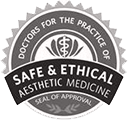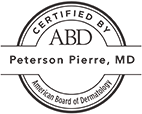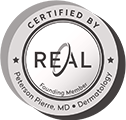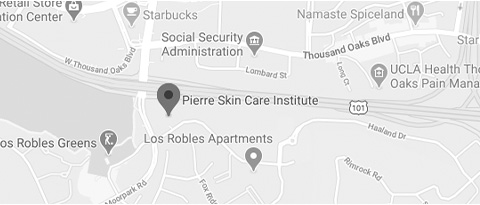Skin Cancer
Get Prevention Tips, Diagnosis, and Treatment in Thousand Oaks
Skin cancer is the most commonly diagnosed cancer in the United States, with more than 3.5 million new cases each year. When it comes to skin cancer, Thousand Oaks’ Dr. Peterson Pierre emphasizes three things: prevention, early detection, and proper treatment.
Financing Options
Financing your care at Pierre Skin Care Institute is easy, convenient, and safe. We offer CareCredit® and Alphaeon® Credit — two trusted and reliable options that allow you the flexibility to make comfortable payments over time in order to get your procedure benefits now.
With one out of every five Americans experiencing skin cancer during his or her lifetime, this is a serious problem that can impact virtually anybody.
Click here to schedule an appointment with Dr. Peterson Pierre to discuss help for skin cancer in Thousand Oaks. You can also call Pierre Skin Care Institute at (805) 496-9190 or send an message online.
What Is Skin Cancer?
Cancer is a disease that involves the uncontrolled division of cells, which can multiply and spread to the point that they damage healthy tissue, organs, and systems throughout the body. This growth typically takes the form of tumors—in the breasts, lungs, prostate, colon, or elsewhere—though cancers of the blood do not necessarily form solid masses.
Skin cancer, specifically, is a cancer that develops when skin cells begin to grow out of control. There are several types of skin cancer, but the most common three types are basal cell carcinoma, squamous cell carcinoma, and melanoma.
Basal Cell Carcinoma
The base of the outermost layer of your skin—known as the epidermis—is made up of specialized cells known as basal cells. These basal cells are essentially skin cell factories. They build new skin cells, which then migrate upward until they get to the surface, die, and are sloughed away. This natural turnover keeps the skin healthy.
Skin cancer that forms in this layer is known as basal cell carcinoma. This is the most common form of skin cancer. It is typically slow moving and not prone to spreading into surrounding tissues, but should still be taken seriously.
Visually, basal cell carcinoma can take the form of rough patches of reddened skin, sores, bleeding pimples that look like bruises that don’t heal, a random scar, or pinkish and glossy bumps.
Squamous Cell Carcinoma
The second most common form of skin cancer is squamous cell carcinoma, which forms in the cells that make up the epidermis. These flat cells are higher than basal cells in the outermost layer, and they are also more likely to spread when malignant. Squamous cell carcinoma is responsible for about 2,500 deaths each year in the United States.
This skin cancer often resembles a wart, open sore, or rough patch of skin.
People who develop squamous cell carcinoma are typically adults over the age of 50 and/or those who have had a basal cell carcinoma in the past.
Melanoma
Melanoma is rare, but also the most deadly form of skin cancer. This cancer develops in the melanocytes, which are cells responsible for giving the skin its color. It can develop rapidly and readily spread to other areas and organs, so early detection and treatment are key.
Growths resemble moles, but can change in color, shape, or size. They can appear red, purple, white, blue, pink, or the tone of your skin, but they are more typically black or brown.
This skin cancer is responsible for around 9,000 deaths annually in the Unites States.


Meet
Dr. Peterson Pierre
As a Stanford Medical School graduate and dermatologist certified by the American Board of Dermatology, Dr. Peterson Pierre ("the Gentle Injector") is a highly respected leader in the industry with a reputation for exceeding patient expectations.
What Causes Skin Cancer?
Doctors are continuing to study cancer, including skin cancer, to determine what makes the disease develop in certain people. While a range of factors may be responsible—from environmental pollution to genetic makeup—skin cancer is linked very closely to sun exposure. Specifically, the ultraviolet radiation given off by the sun is at fault. This radiation also comes from tanning beds.
Exposure to ultraviolet radiation causes genetic changes in the skin’s DNA, which results in the uncontrolled growth of skin cells. These cells can form scaly lesions called actinic keratosis, which can eventually transform into malignant tumors.
Because skin cancer is so closely linked to sun exposure, prevention—in the form of daily applications of sunscreen, avoiding peak sunlight hours, and other smart sun practices—is the best thing anybody can do in the fight against the disease. A person’s skin cancer risk goes up with cumulative sun exposure, as well as after severe burns, so it is especially important to protect children from ultraviolet radiation as much as possible.
Be aware that certain prescriptions, autoimmune illnesses, or skin injuries can provoke the growth of squamous cell carcinomas, so it is important to have any unusual growth examined by a dermatologist, whether it appears in an area prone to sun exposure or not.
What Can Be Done About Skin Cancer?
While skin cancer is one of the easiest cancers to diagnose and treat, many patients don’t understand the importance of having regular screenings and examinations. You may not think much of a new growth on your skin and ignore it for a while before having it checked by a qualified dermatologist, but this is never a good idea.
The earlier skin cancer is diagnosed, the less likely it will be to spread and become a major problem. Whenever you notice any changes in your skin, please visit Dr. Pierre for an examination.
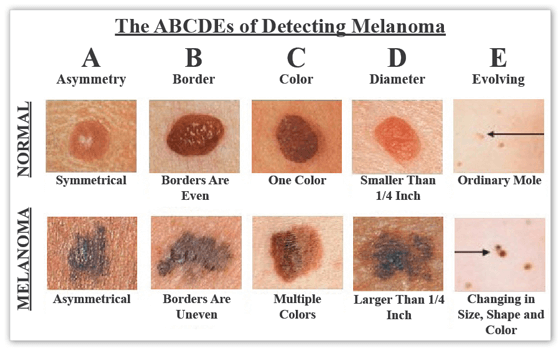
The ABCs of Skin Cancer
Routine self-checks are an ideal way to spot suspicious growths and mark whether they are changing from month to month. In general, watch for lesions that resemble moles, but that have any of the following characteristics:
- A—Asymmetry. If the two halves of a lesion don’t match, the lack of symmetry can indicate the uncontrolled growth of skin cancer.
- B—Border irregularities. A benign lesion tends to have smooth, defined edges. Skin cancer borders may be notched, scalloped, or indistinct.
- C—Colors. Moles are often dark brown, so a variation in color can be concerning. Skin cancer can even cause growths to be multi-colored.
- D—Diameter greater than a pencil eraser. Cancerous lesions can be any size, but the larger a growth is, the more suspicious it is.
- E—Evolving. Moles do tend to stay a uniform size and shape, so a lesion that gets larger, changes colors, begins crusting or bleeding, starts to hurt, or otherwise evolves can indicate skin cancer.
Annual check-ups with a doctor are important, but growths that exhibit any of these ABC signs warrant a special visit. Make an appointment to have suspicious lesions examined so Dr. Peterson Pierre can diagnose and begin treating skin cancer as soon as possible, if necessary.
During an examination, Dr. Pierre may do a full body check, as well as a close examination of any area of concern. If he believes that a suspicious skin growth is not a standard mole or wart, then he may perform a biopsy. This involves removing a small portion of the growth and sending it to a laboratory for further investigation. The laboratory will be able to determine if there are cancerous or precancerous cells present.
If cancerous cells are found, Dr. Pierre may recommend any of a variety of options.
The most common treatment for skin cancer is surgical excision, which means removing the tumor and surrounding tissue to take the cancerous cells out of the body before they have the opportunity to spread. This is another reason why early detection is preferred.
Depending on the location and size of the tumor and your health, Dr. Pierre may recommend seeing a specialist for Mohs micrographic surgery. This incredibly precise skin cancer treatment spares as much surrounding healthy tissue as possible, making it ideal for tumors that develop in sensitive, delicate, and particularly visible areas.
In some cases, Dr. Pierre may make a referral to an oncologist for traditional radiation or chemotherapy.
In cases where the skin cancer treatment results in a noticeable scar or divot in the skin, reconstructive surgery may be necessary.
Why Choose Pierre Skin Care Institute for Help With Skin Cancer in Thousand Oaks?
Dr. Peterson Pierre is a board-certified dermatologist with considerable experience in medical dermatology. He has dedicated his career to improving the lives of his patients through accessible care, accurate diagnosis, and personalized treatments.
If you have an unusual skin growth or changes in moles or freckles that are causing a concern, contact Pierre Skin Care Institute today to book an appointment. Dr. Peterson Pierre and his team are here to help patients young and old in a state-of-the-art facility.
For help with skin cancer in Thousand Oaks, Click here to schedule an appointment with Dr. Peterson Pierre, call (805) 496-9190, or send an online message. Pierre Skin Care Institute serves Westlake Village, Agoura Hills, Calabasas, Burbank, Sherman Oaks, all of Simi Valley, and beyond.






